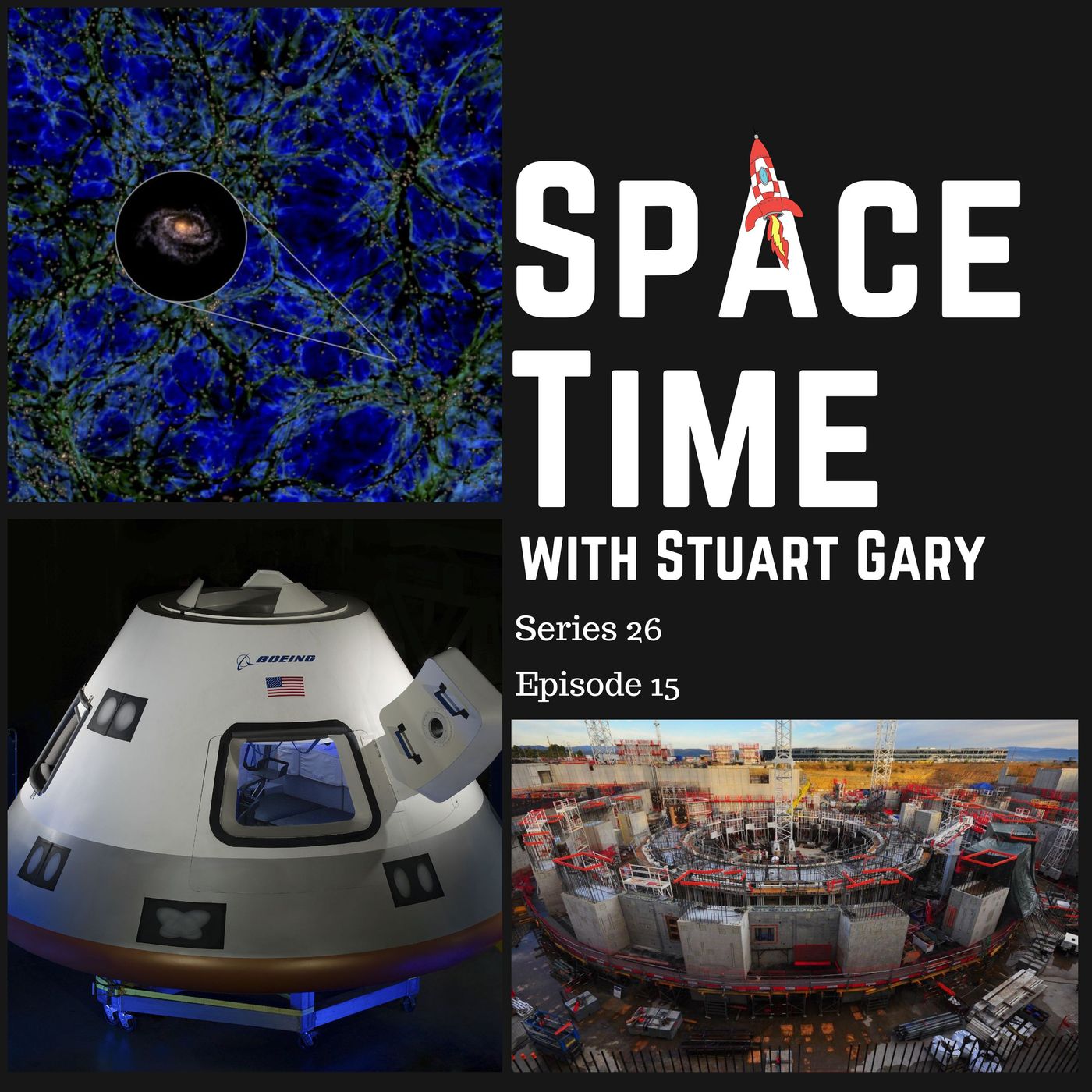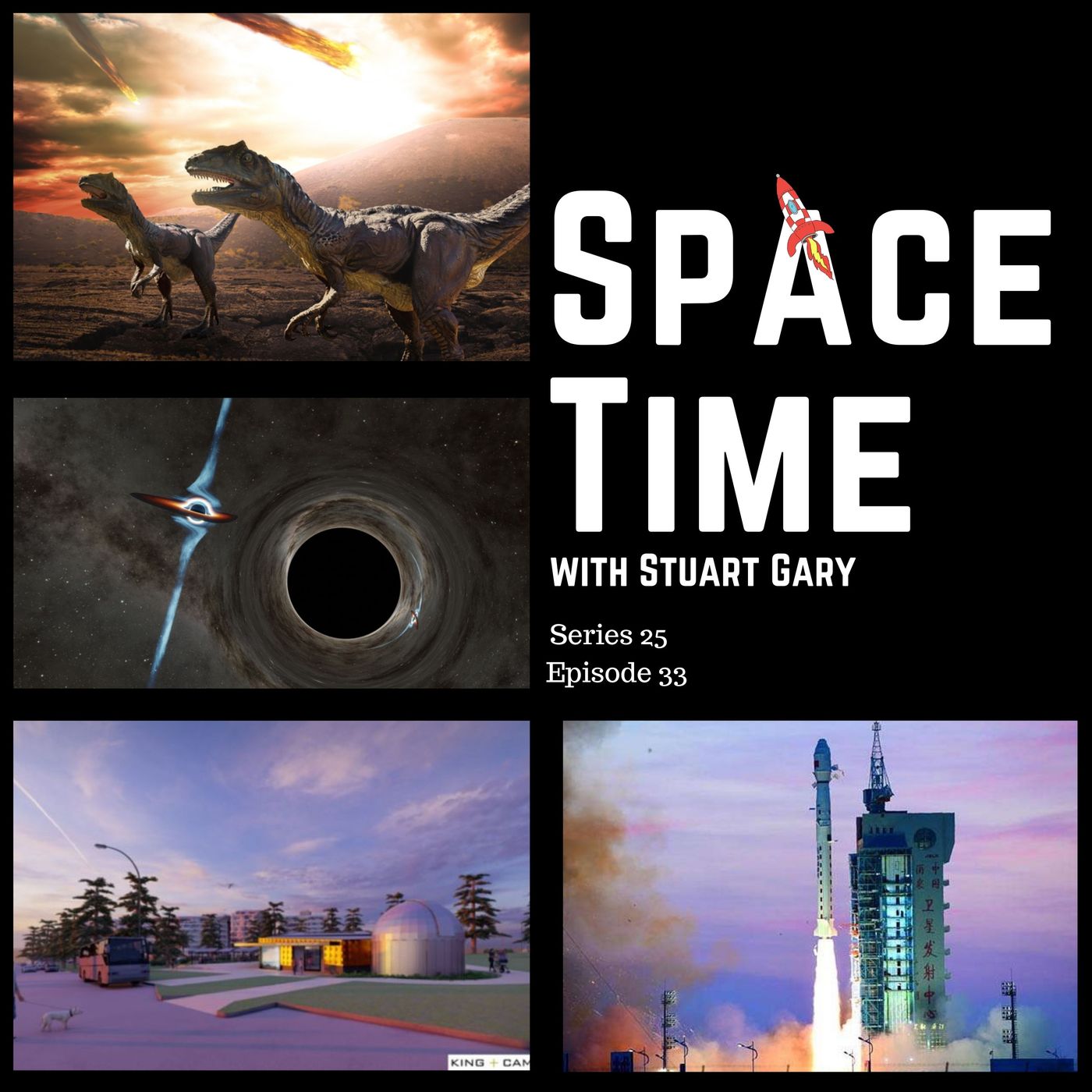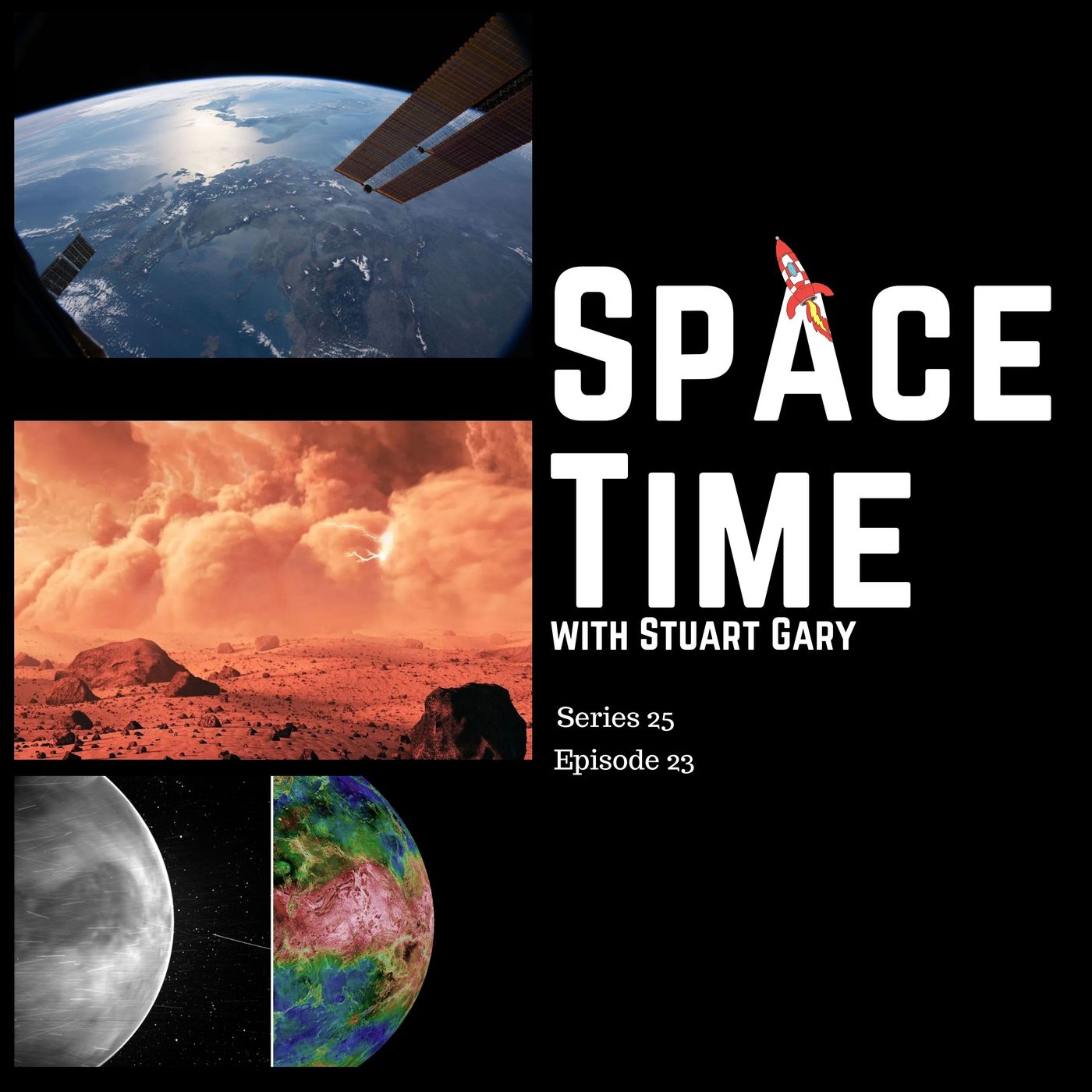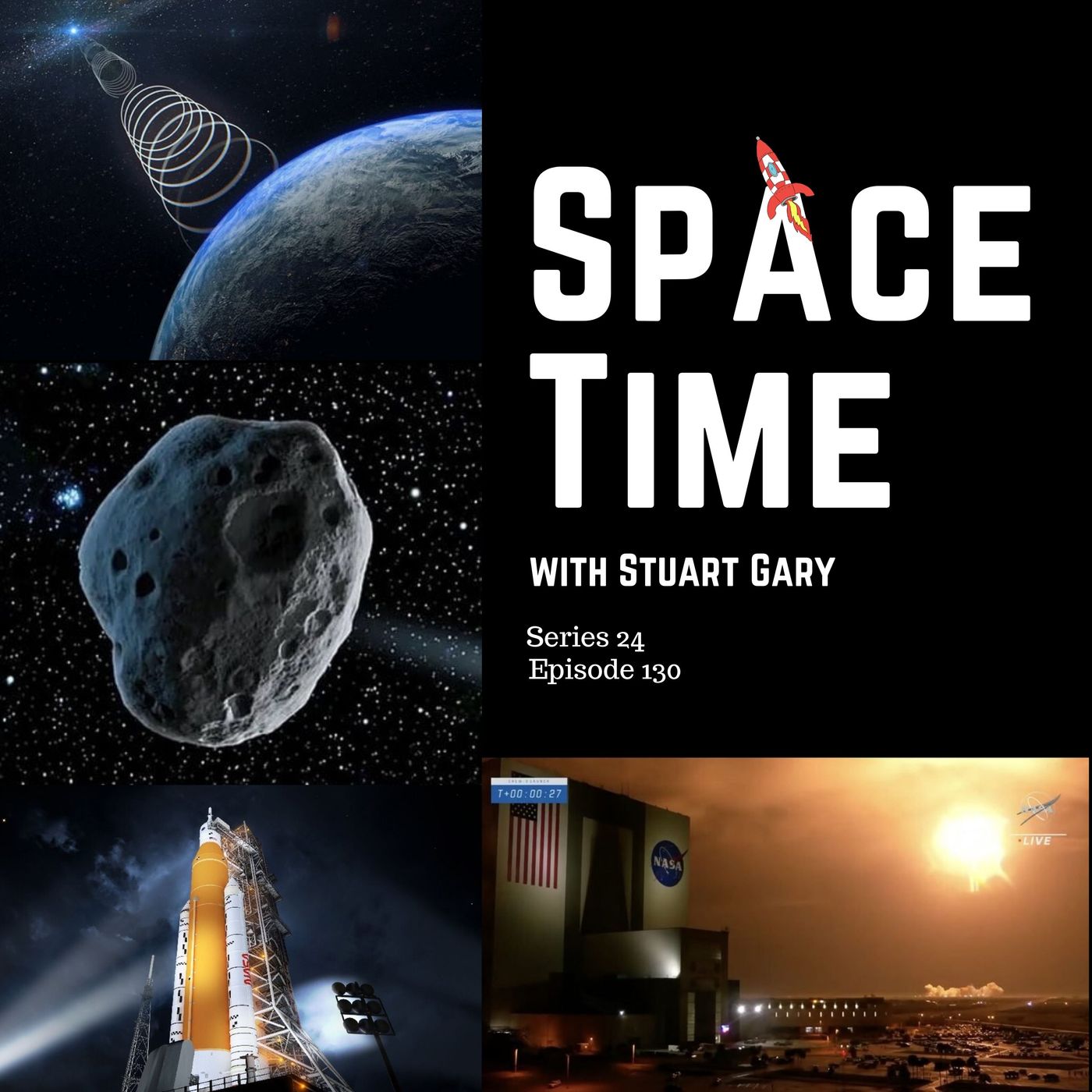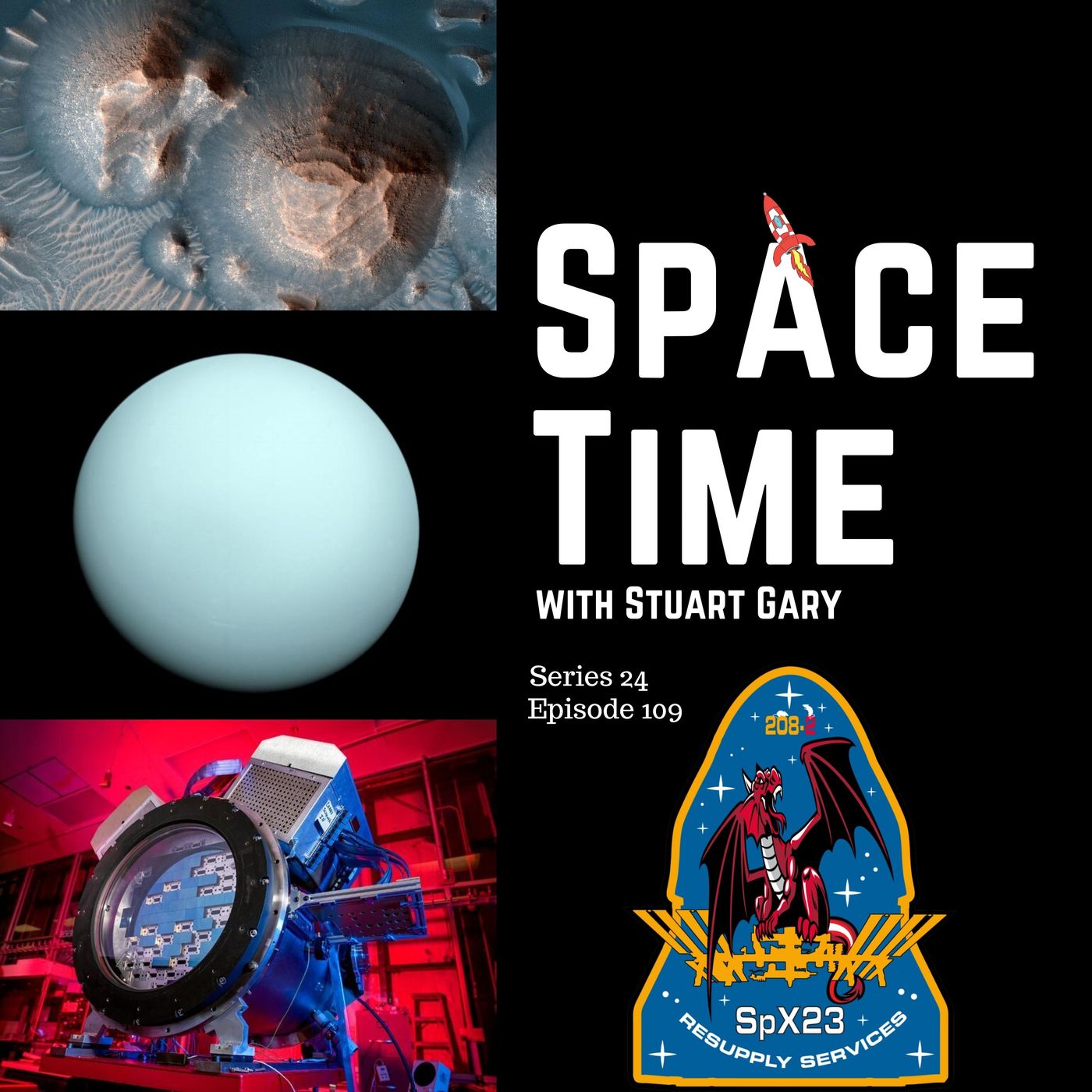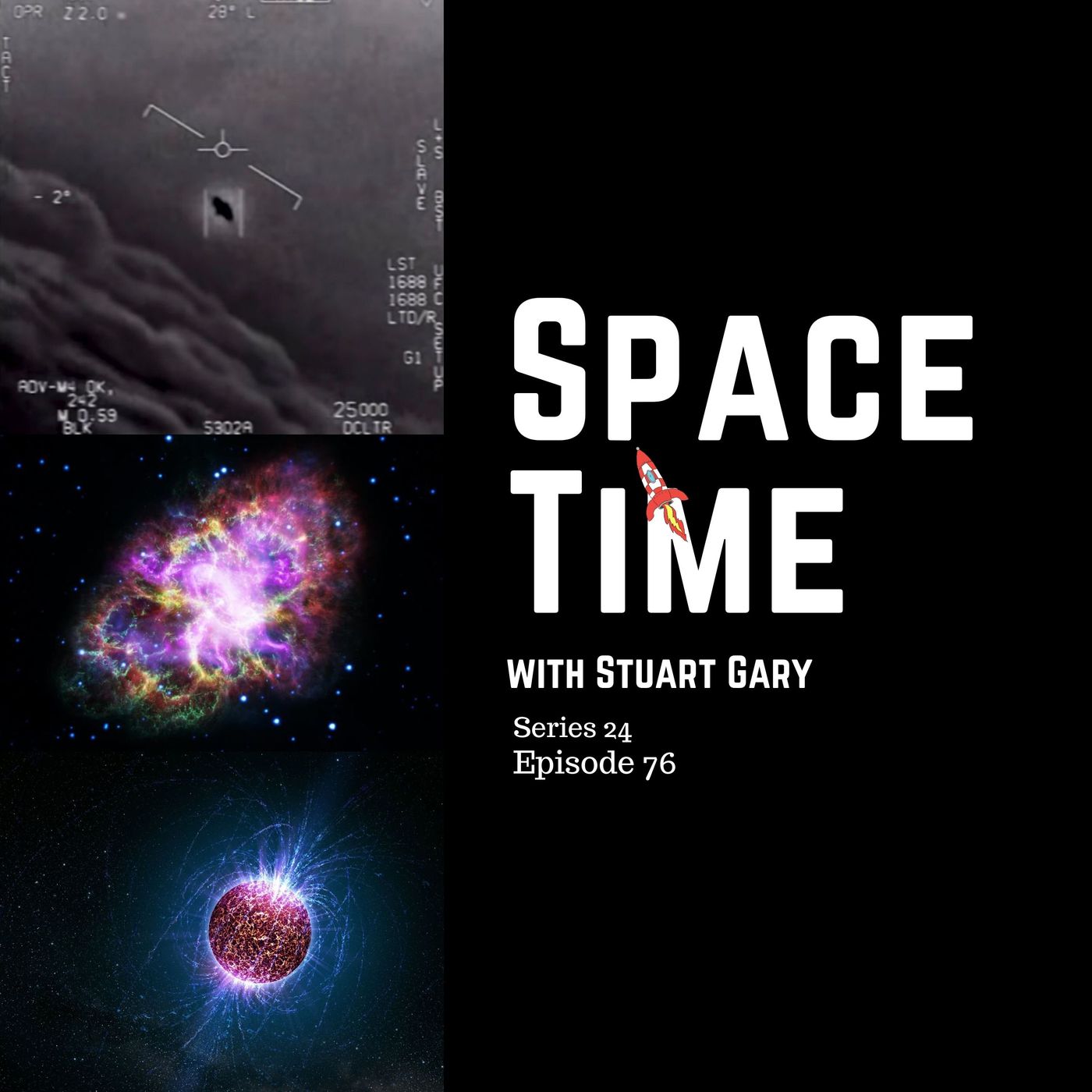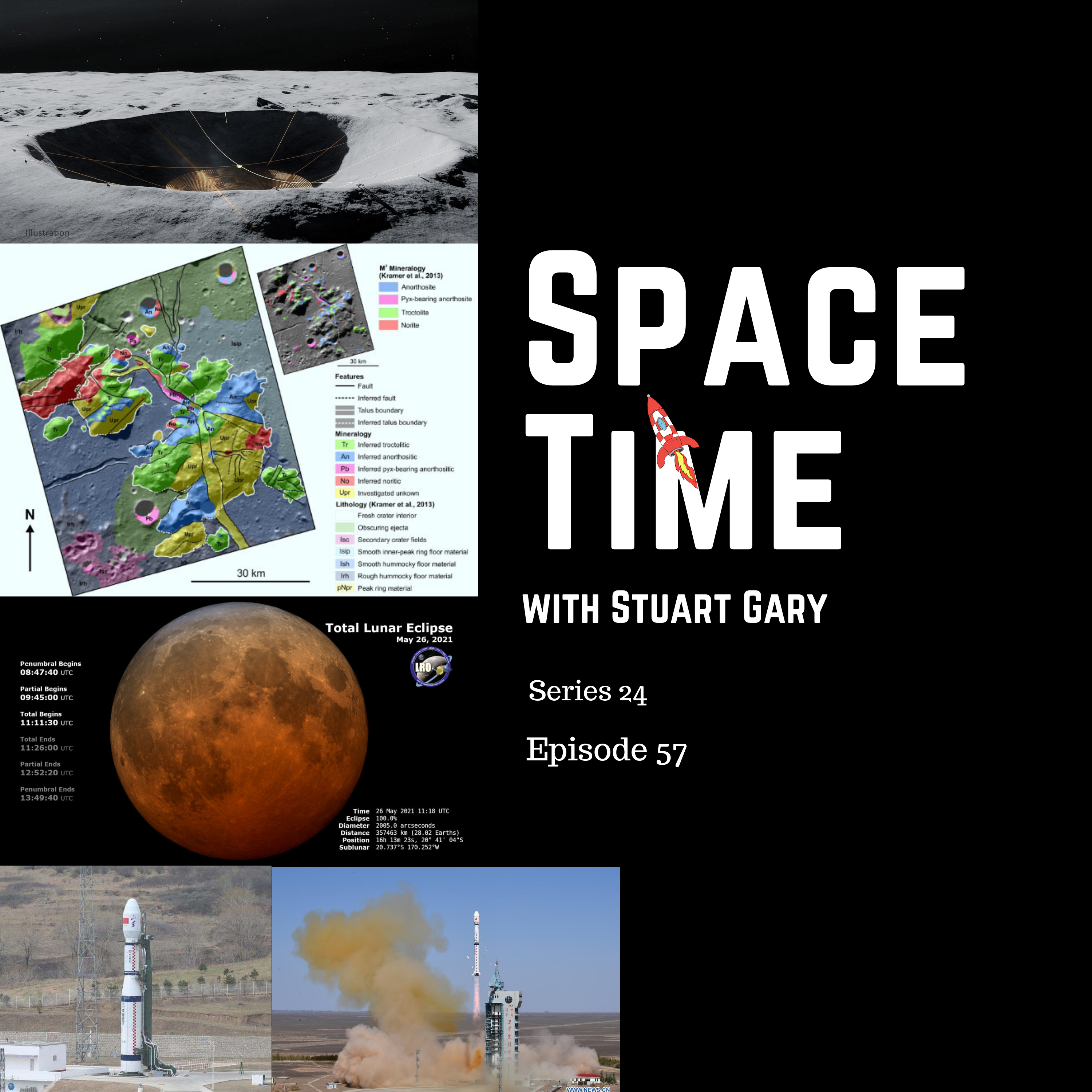Four-Billion-Year-Old Planetary Crust Found Under Western Australia
The Astronomy, Technology, and Space Science News Podcast.
SpaceTime Series 25 Episode 96
*Four-billion-year-old planetary crust found under Western Australia
Scientists have identified a four-billion-year-old piece of the Earth's crust the size of...
The Astronomy, Technology, and Space Science News Podcast.
SpaceTime Series 25 Episode 96
*Four-billion-year-old planetary crust found under Western Australia
Scientists have identified a four-billion-year-old piece of the Earth's crust the size of Ireland underneath what is now Western Australia.
*The origins of Earth’s water
It was revealed this year that Earth’ received its life-giving water during its formation in the protoplanetary disk from which the Sun and solar system were created 4.6 billion years ago.
*Suspended animation for long distance space flights
A new study has ruled out using suspended animation for long distance space flights.
*Astronaut bone density study
A new study has shown that astronauts on long missions experience the equivalent of 10 years of age-related bone density loss, even after 12 months of recovery.
*The Science Report
Study shows becoming a parent, rather than simply getting older makes you more conservative.
A new prototype electrolyser that can convert the humidity in the air into hydrogen.
How fortune tellers make men take more risks with money.
Alex on Tech: Apple’s new iPhone 14
Listen to SpaceTime on your favorite podcast app with our universal listen link: https://spacetimewithstuartgary.com/listen
For more SpaceTime and show links: https://linktr.ee/biteszHQ
If you love this podcast, please get someone else to listen to. Thank you…
To become a SpaceTime supporter and unlock commercial free editions of the show, gain early access and bonus content, please visit https://bitesz.supercast.com/ . Premium version now available via Spotify and Apple Podcasts.
For more podcasts visit our HQ at https://biteszhq.com
Your support is needed...
SpaceTime is an independently produced podcast (we are not funded by any government grants, big organisations or companies), and we’re working towards becoming a completely listener supported show...meaning we can do away with the commercials and sponsors. We figure the time can be much better spent on researching and producing stories for you, rather than having to chase sponsors to help us pay the bills.
That's where you come in....help us reach our first 1,000 subscribers...at that level the show becomes financially viable, and bills can be paid without us breaking into a sweat every month. Every little bit helps...even if you could contribute just $1 per month. It all adds up.
By signing up and becoming a supporter at the $5 or more level, you get immediate access to over 280 commercial-free, double, and triple episode editions of SpaceTime plus extended interview bonus content. You also receive all new episodes on a Monday rather than having to wait the week out. Subscribe via Supercast (you get a month’s free trial to see if it’s really for you or not) ... and share in the rewards. Details at Supercast - https://bitesznetwork.supercast.tech/
Details at https://spacetimewithstuartgary.com or www.bitesz.com
To receive the Astronomy Daily Newsletter free, direct to your inbox...just join our mailing list. Details at https://www.bitesz.com/show/spacetime/p/astronomy-daily/
The Astronomy, Space, Technology & Science News Podcast.
SpaceTime Series 25 Episode 96 AI Transcript
Stuart: This is Spacetime Series 25, episode 96 for broadcast on the 14th September, 2022. Coming up on Spacetime 4 billion yearold planetary craft found under Western Australia a new hypothesis for the origins of Earth's water. Anna works in the movies. But would suspended animation or stasis really work for long distance spaceflight? All that and more, coming up on, um, Space time. Welcome to spacetime with Stewart gary Scientists have identified a 4 billion year old piece of the Earth's, uh, crust roughly the size of island underneath what is now Western Australia. The discovery, reported in the journal Terranova is among the oldest segments of the planet's crust ever identified. The oldest currently known slice of planetary crust on Earth is the Canadian Shield on the eastern shores of Hudson Bay which has been dated to four 3 billion years. That's just 300 million years younger than the planet itself. And 200 million years after the giant Fear impact in which A. M. Marsized planet slammed into the early proto Earth eventually giving rise to the Moon. The only oldest stuff originating from the Earth are Zerk on minerals dating back some four 4 billion years. They were found at Jack Hills in the mid north of Western Australia. Finding really ancient rocks is difficult on Earth because the planet's crust is constantly being weathered by wind and water erosion and through seduction back into the metal due to plate tectonics. This means that most of the planet's surface rocks are at very best only one or 2 billion years old and most are much younger than that. One of the studies authors, Max Drama from Curtin University says finding much older crust suggests that something special must have occurred during this epoch in Earth's, uh, history. The newly discovered section of venture crust was found in sediment from the Scott coastal plain south of Perth which eroded out of much deeper, uh, Australian continental rocks. The authors reached their conclusion by undertaking radioactive dating of zircon uh, crystals found in the rocks. Zircons are extremely durable crystals that resist melting an erosion once they're formed. That means they often survive the very rocks they formed in. The authors vaporized the circums using powerful lasers then analyzed the decay ratios between two radioactive elements. They contained uranium to lead and lidium to halfnium. Because these elements radioactively decay at set rates they can be used as geological clocks to date the zircon minerals they were formed in. The authors then used Earth observation satellite data uh, to learn exactly where these minerals came from. Because Earth's, uh, crust varies in thickness gravity varies slightly across the planet's surface. And by measuring these variations the authors identified a thick section of crust around the Scott River region which is part of the massive 1000 square kilometer yoga crate on which covers a third of the state and includes Jack Hills to the north. This ancient crust is buried tens of kilometers below today's surface and includes a boundary area associated with gold and iron ore deposits. Understanding the formation of crust 4 billion years ago will help researchers better understand how our continents first formed. This is spacetime. Still to come, a new hypothesis for the origin of Earth's water. And it works fine in the movies. But could suspended animation in other words, stasis really work for long distance spaceflight? All that and more still to come on Space Time new hypothesis published earlier this year suggests that Earth received its life giving water during its formation in the protoplanetary disk from which the sun and solar system were created 4.6 billion years ago. The findings, which were reported in the journal Nature Astronomy, were based on a detailed evaluation of the hydrogen to derive ratios in water of an ancient meteorite as orders the solar system itself. Water is essential for life as we know it. It's made up of molecules of hydrogen and oxygen. A hydrogen atom is usually made up of a single proton in its nucleus orbited by an electron. A heavier version of hydrogen, called deuterium adds a neutron to the proton of the nucleus. For years, scientists pondering the origins of Earth's uh, water were convinced it must have come to the Earth through comet and asteroid impacts which reached their peaks and three 9 billion years ago during a period known as the Late Heavy Bombardment. This was caused by the migration of the gas giants Jupiter and Saturn from the inner solar system out to their current locations. Now, the reasoning behind this water origin hypothesis was the enormous amounts of heat generated during the Earth's formation, which saw the early prato Earth as nothing more than a seething bubbling magma ocean. Especially after the Marsized planet Thea slammed into it, blowing off so much ejector, it eventually coalesced to form the Moon. So with the Earth being nothing more than a molten magma ocean, it was thought any water that would have been there would have evaporated away. So how did the water get here? Well, astronomers always thought that comets, being basically big muddy snowballs which contain a lot of water, may be a good contender. However, the problem is when astronomers began analyzing the composition of water inside comets, they found that the hydrogen to delirium isotope ratios were different from that of Earth's water. It turns out the further away from the sun you get, the less deuterium water contains. And comets originate a long way from the sun in the outer solar system. So if Earth's water didn't come from comets, where did it originate? And this is where Geochemist Jerome Alliance from the French National Museum of Natural History comes in. He was studying the 457 billion year old Ephraimovka meteorite which was discovered in Kazakhstan in 1962 when he analyzed the hydrogen and its calcium aluminum rich inclusions, or CAIs, using a new technique involving a focused ion beam. This meteorite analysis showed that during the first 2000 years of the solar system's, existence. And before the planetesimals had formed, two large gas reservoirs existed. One of these reservoirs contained the solar gas from which the matter in our solar system ended up condensing. The other was apparently rich in water from a massive influx of interstellar material that fell in towards the inner solar system just as the protocol envelope was collapsing to form the sun. And before the Earth had fully formed. And fascinatingly, this interstellar water had a similar isotope composition to Earth's water. A full report on the discovery is contained in the current issue of Australian Sky Telescope magazine. The magazine's editor, Jonathan Nulli, says this suggests that the water was present in the early solar system from its very inception and before the Earth was formed.
Guest: Stewart yes. So where did Earth get all its water? Where the water world? We've got all these huge oceans, water everywhere, this magnificent water cycle. We've got Antarctica down there. We've got polar ice caps, we've got clouds, uh, where we really are water planets. So where did all this water come from? And for a long, long time, people thought, well, Earth must have, uh, been bombarded in its early years by lots of comets. And there would have been far more comets around billions of years ago than there are now. And comets are made basically mostly of water ice. So bombardment of comets could have brought a lot of water to the Earth. Because the thing is, when the Earth formed in the early days of the solar system, everything would have been really hot. The whole environment would have been incredibly hot. And it would have been difficult, if not impossible, for water to form pools and lakes and oceans and things on a hot planet in a hot environment. So the thinking was that after things cooled down a bit, this comet bombardment came along and that's where we got on our water. So that was the idea for very long time. And the difficulty is that some researchers come up now and they suggested that if it wasn't courtesy of a bombardment of comets, we might actually have formed with the water in place. And the reason for this is that there are a couple of different kinds of hydrogen atom. It turns out that much of the type of hydrogen in Earth's water molecules doesn't match the type of hydrogen, uh, or at least the ratio of the two types of hydrogen that you find in comets. Because comets from way out there in the distant part of the solar system are sort of like frozen time capsules and they're thought to, um, encapsulate the conditions that they formed in there. So they're sort of like pristine samples of the type of water, frozen water that they were made with. And the type of water we've got here on Earth, or at least the ratio of the different kinds of hydrogen atoms, is slightly different. So scientists have analyzed a meteorite that was found in Kazakhstan back in the 1960s. And this meteorite has crystals in it that indicate that it formed in the hot environment of the early solar system where the Earth would have been as well. Now, the scientists have found that the ratio of the two types of hydrogen suggests that the water was already in and on the, uh, Earth when it was forming. It matches, you see. And they also think that this particular type of water or some of it at least, might have actually come from outside the solar system when the solar system was forming and got sort of dragged in and mixed in with all the big cloud of gas and dust from which the sun and all the planets, uh, eventually formed as this cloud was collapsing inwards. So that's really interesting so that we didn't have this we might have thought of had a comet bombardment but could have brought enough water of the hydrogen ratio type that we now have. So it looks like we actually formed with the water in place. So we really are the water board and have been for a very long time.
Stuart: There was the normal water that formed in the protoplanetary disk and then the second body of water infiltrated into the solar system. And it's the second body which the Earth water came from.
Guest: Yeah. So, um, it's interesting to see how ideas change, uh, over decades and decades and decades as new evidence comes along.
Stuart: And get a lot more complicated.
Guest: They can get a lot more complicated. But the beauty is that we've got all these new techniques of analyzing things these days, too. And ideas tend to sort of stick in science for a very long time and then something will come along and turn it upside down. For instance, Newton's ideas of gravity and all that sort of stuff. And that stayed that way for a couple of hundred years.
Stuart: They say that science is progression, can be measured in tombstones.
Guest: Well, you only have to go back probably, what, about 130 years towards the latter part of the 19th century, the late 1800s, where physicists some physicists at least proudly proclaiming all physics is now known. We've sorted the whole thing out. There's nothing more to learn.
Guest: I got it all done.
Guest: And then along comes relativity and quantum mechanics and the atom and all sorts of other things, um, before the fall. The old saying, isn't it? So it's the same thing with this is not a major one, the Earth's water. But the idea had been settled on for a long time that the water came from comets. And the other thing that sort of fed into that, too, probably starting in the maybe 80s or so was that they started to detect amino acids and things in bodies out there in space. And then it was thought that maybe comets brought some of the building blocks of life to Earth as well. So it all seemed to make a lot of sense. And look, comets would have bombarded the Earth too, and some of the water would have come from comets. Maybe they did bring some amino acids and things. But that idea sort of stuck for a very long time until this new evidence came along when we had new investigations and new techniques for investigating, um, and analyzing, um, meteorites and other things that we just simply couldn't do before. So sort of episodic the way these sort of scientific ideas go, what they had before was the best idea. They can come up with the information they had at the time. And now we've got a new idea with the best information we've got at this time. And who knows what it's going to be 30 years from now when we might have made some huge other discoveries somewhere else. Maybe 30 years from now. We will be analyzing planets that orbit other stars and be getting all sorts of great information from them and maybe even pictures. And be able to sort of see equivalents to Earth out there forming or having already formed or in the process of forming. And get some clues then to how our planet formed and the processes that were going on in our neck of the woods about four and a half billion years ago. It's exciting, actually.
Stuart: That's Jonathan Nally, the editor of Australian Sky Telescope magazine. And this is spacetime still to come. It works fine in the movies, but could suspended animation or stasis really work for long distance spaceflights? And later in the Science Report, a new prototype electrolyzer that can convert humidity in the air into hydrogen. All that and more still to come on space time. Well, it works great in Sci-Fi, but in real life, putting someone or something at a stasis that is suspended animation in order to undertake long distance spaceflights simply isn't going to work. Chilean researchers set out to investigate whether humans could harbonate like bears, enabling people to remain in stasis during long trips through space that last more than a normal human lifetime. But they found that it's unlikely to work because humans simply wouldn't save enough energy during hibernation. They looked at metabolism during hibernation in mammals ranging from bats to bears, and say that a gram of tissue in a bat has a similar metabolism to a gram of tissue in a bear during hibernation, despite the bear being nearly 20,000 times bigger. But working at the likely metabolism of a hibernating human based on our mass, they found that we save more energy simply by sleeping than what we would by hibernating. The findings reported in the Journal of the Proceedings of the Royal Society B are bad news for scifi fans, suggesting that humans will simply never be able to survive in suspended animation during long trips through space. A new study has shown that astronauts on long missions experience the equivalent of ten years of agerelated bone density loss even after twelve months of recovery back on Earth. The findings, reported in the journal Nature Scientific Reports, investigated the shinburns of 17 astronauts after being in space and found that people who weren't on space missions for longer than six months had substantially less bone recovery than those who were in space for less than six months. Altogether, nine of the astronauts studied did not fully recover their shinbone total mass mineral density even after twelve months of recovery across all astronauts. Those who completed the greatest amount of inflight deadlift training relative to their individual training preflight were identified as part of those who did recover at tibia bone mineral density. This is space time and time that I take another brief look at some of the other stories making news in science this week with a science report. It's often claimed to have been Winston Churchill who coined the phrase if you're not a socialist at the age of 20, you have no heart. But if you're not a conservative by the time you're 40, you have no brains. And it seems to be anecdotally true. Have you ever noticed how people often start out with very liberal or even radical ideas, but they become more and more conservative as they age? Now, a study reported in the Journal of the Proceedings of the Royal Society B may have come up with the answer, and the key is becoming a parent rather than simply getting older. Apparently, when you have kids, it pushes your social values to the right. Through a series of surveys, scientists demonstrated that parenting motives, parenthood or parental care motivation such as feelings towards a child crying fundamentally influence social conservatism all around the world. And attitudes to subjects such as abortion, welfare and national security become far more conservative as the number of kids you have increases. Of course, that also means that the growing tendency to have fewer kids, or none at all, could contribute to future liberalization on social issues. Scientists have developed a new prototype electrolyzer, which can convert humidity in the air into hydrogen. Because current methods to create hydrogen for energy require pure water that could otherwise be used for drinking, scientists developed a way to use the moisture in humid air to avoid competing for resources. They say their device, which absorbs moisture in the air and splits it into hydrogen and oxygen, could be powered by renewable energy, such as solar and wind, and can operate with humidity as low as 4%. The research, reported in the journal Nature Communications, could be scalable and could help provide hydrogen fuel for emergency semiarid regions. A new study has shown that many receive a, uh, positive reading from a fortune teller, ended up taking more financial risks following the reading than those whose reading was negative or neutral. The findings, reported in the journal Plus One also found the link was a lot less pronounced for women than men. The researchers conducted two experiments using 293 participants who were given either positive, negative, or neutral fortune readings. They were then asked to complete a questionnaire, uh, evaluating their tendency to take financial risks. The authors found that participants with positive fortunes were more inclined to take financial risks, especially if they were male. In another experiment, they found that people with a positive fortune ended up gambling more real money afterwards in an online game, although no difference was seen between men and women in that experiment. Now, crunching all the data together, they found the link between positive fortune and financial risk taking only held true for men. Interestingly, most of the participants didn't believe in fortune telling, but this didn't affect their outcomes. Apple has launched its new iPhone 14 models, as well as the new AirPods Pro and three new Apple Watches. Technology editor Alexarerovroit From iTWire.com says it's the most bountiful harvest yet.
Guest: From Apple's Orchard, they've launched four new iPhone models. The 14, the 14 plus, and then the two Pros, the Pro and the Pro Max. They've launched the new second generation AirPods Pro, and they've also launched three new Apple Watches, the Se, which is the, uh, lower cost version, which is slightly cheaper than the original, uh, model of the Se, the Apple Watch Series Eight, which has car crash detection and two temperature sensors, and also a new Apple Watch Ultra, where every model comes with LTE in Australia, $1,299. And they're able to work at incredibly low temperatures. They're very robust with titanium and a sapphire glass, uh, screen. Let me tell you a bit about the iPhone 14 model. So all iPhone 14 models have new satellite connectivity. Now this is coming later this year, and it's for the US and Canadian markets to start with only, and it's going to be free for two years. But what it allows you to do is hold your phone to the sky. It has an interface that will show you that you are sort of connected to a particular satellite. The connection could take several minutes, but once you're connected, you can then send messages. Now, Apple has created a bunch of messages which are designed to quickly get the message across because it can take minutes for a message to send or come back. And there's no voice with that yet. But if you are in, uh, an area where there's no cellular connectivity, this is something that will eventually be standard on all phones. And it doesn't require a, uh, satellite sleeve or a special satellite phone. It'll just be a standard feature of your phone. So iPhone 14 is the first to get it. Now, the iPhone 14 Pro has ditched the notch and has taken a chill pill. So what I mean by that is that it now has what it calls a dynamic island. So it's like the notch has been lowered. And above what was the notch, you can see the screen with the notch itself. It's a 30% smaller uh, Face ID sensor and front facing camera. Front facing camera has auto focus as well.
Stuart: Didn't I tell you when the notch first came out, it was a bad idea? I remember saying that to you on Air.
Guest: Yes, you did. You did say that. For most people, it just effectively ignored it. But now Apple has embraced the fact that it needs space on the screen to maintain a bezel free environment around the screen itself. And that little pill shape is now dynamic, so that black area can widen in size to show you notifications, to show you that you've had your Face ID successfully scanned, to show you timers, to show you how far away your Uber or Lyft right is. And it's dynamic. So it moves, it grows, it shrinks. And they've managed to take something that companies have sort of hoped to ignore and made it into a feature that is actually delivering real benefit. No one else has been able to do something like that, and it's quite cool. Also, the cameras on all the phones have been updated. They all now take two times better lowlight photos. And on the Pro models, there's now a new 48 megapixel main sensor, where each pixel is now made up of four separate pixels, so they merge them together. So 48 divided by four is twelve. So that's what gives you the twelve megapixel sort of size that you used to seeing. But if you're a Pro photographer, you can actually use all 48 megapixels, and you actually now have a, uh, two times equivalent optical zoom. So although you only have three lenses, you have the zero five optical wide, the one time standard, the two times optical equivalent, because it can use that larger 48 megapixel area to take a two times optical zoom equivalent shot without zooming up the one time, and you've got the three times optical telephoto. So the cameras have been improved to take better photos. The front facing cameras are autofocus, the are bigger, sensors are leading more light, and you've got improved cinematography mode, so that's when you look at something and then something looks at something else and the focus changes, that's been improved. There's also a new action cam mode on all the new iPhone 14 models, where it can zoom in a bit and use stabilization software and hardware to give you an ultra stabilized shot that is effectively negating the need for a gimbal. But if you don't have an iPhone 14 and you want the stabilized shots, then your gimbal will still get a lot of use and can be used with other phones as well. And that is probably going to be even more stable than what Apple has been able to do. But Apple also launched the new second generation AirPods Pro twice the noise cancelation when you've got transparency mode. If the AirPods here lots of noise, like from a jackhammer with construction, it's analyzing the sound 40,000 times price per second and it can mute those sort of sounds or make them much dimmer. So you are not being assaulted by this very loud sound. There's a new HT Ah chip inside that does all of this. And there um, was talk that Apple would remove the stems from the AirPod Pro because a lot of the competition doesn't have stems. The Google Buds, the Pixel buds, the Jabra, they don't have the stems. But Apple like the stems because you can squeeze them to pause, play, stop, bring up Siri go from noise cancellation to transparency. But I've always wondered why couldn't you just swipe your finger up and down the stem to change the volume? Well, I've done that. So now you've got manual volume controls on the second generation AirPods Pro. The previous ones don't have that, but the new ones will. And uh, that's going to be the most exciting new AirPods yet. The actual case as well gives up to 30 hours of battery life. The AirPods have 6 hours of battery life. The case can be charged by your MagSafe charger, by a Chi wireless charger, or by your Apple Watch charger. And it's got a new speaker inside to make it easier to locate if you're using the fine mice. But also you'll hear sounds when battery is low and when it's charging. So they've really upgraded the case on their phones as well and they've kept the prices basically the same as what they were, despite the inflation. That has been everyone, uh, which is great news for consumers who want to upgrade.
Stuart: What sort of plug does the Apple have this time?
Guest: Well there was lots of talk that they would go to USBC and the European Union has mandated that they do that by 2024. So USBC is still there to plug into the actual uh, wall charger. But the bit that plugs into the phone is still Lightning. Lightning is still a great connection. Most of the accessories are still using Lightning. And um, there's even talk that Apple will next year go with a port list for that has no ports at all. In fact, for the US models of the iPhone 14, they now have dual e sims and they have no physical SIM slot at all. Now I don't think that that's going to be the case in Australia. I think we still have a SIM slot here, but Apple's getting rid of the SIM slot. It's one less place for getting into a phone, one less little piece of uh, equipment that has to manufacture it's, more security, nobody can pull your SIM card out. And uh, the other thing that we didn't get with the iPhone 14 this year is no five G millimeter wave connectivity in Australia. That's still in the US. Only five G millimeter wave gives much faster levels of five GB 5G, over 1000 megabits in many places. But you need to have really close line of sight to the towers. Hopefully we'll get it with the iPhone 15 next year.
Stuart: There's also news from LG and uh, also Google.
Guest: Yeah, well, LG has given up on making phones, but at IFA they announced that the OLED screen technology is able to go from a flat screen to a curved screen, and not just one level of curve, but there are 20 different levels of bendability from flat to whatever the deepest curve is. Now, curved TVs were actually available for a while, but people wanted the ability to have both, and at the time they couldn't do it. But now technology has moved so much that LG can have rollable displays, which are obviously super expensive at the moment, but cheaper is this ability to have this curved display. And if you've got a family sitting on the couch, having a curved display might not be the best. You might want to go back to flat, but if you're just watching it by yourself, you're right in the middle of the sweet spot. Then having the two curves come out and facing you, it gives you your eye, it matches the curvature of your eye and more closely, approximately, and uh, it gives you more immersion. LG also showcased a um, bendable gaming monitor, which you can use for non gaming computer purposes as well, but with the same technology. When will this come out? Probably sometime in 2023. They were just showcased at the architecture in Germany, so usually those things take a while. We don't have prices yet, but probably they'll be more expensive as they're quite new. So Google will be uh, also announcing new phones in October. They've made this announcement on iPhone day, obviously to get some attention. They'll be launching on October 6 in the US on October the 7th at midnight, for people on the east coast of Australia. They'll have the Google Pixel Seven and Seven Pro, which will have the latest ten store chip and all the advancements that take advantage of Android 13 and no doubt other surprises. There'll be the new Google Pixel Watch that has been uh, previewed at the Google I O earlier this year. There will be uh, most likely more information on the new Google Pixel tablet and there'll be undoubtedly new Google Nest devices. So new generation for their smart speakers and smart screens.
Stuart: That's Alex Zaharov-Reutt from itwire.com And that's the show for now. Spacetime is available every Monday, Wednesday and Friday through Apple Podcasts, itunes, Stitcher, Google Podcasts, Pocket Casts, Spotify, Acast, Amazon Music, Bytes.com, SoundCloud, YouTube, your favorite podcast download provider, and from Spacetime with Stewart Gary.com. Spacetime is also broadcasts through the National Science Foundation on science owned radio, and on both iHeartRadio and tune in radio. And you can help to support our show by visiting the Spacetime Store for a range of promotional merchandising goodies. Or by becoming a Spacetime patron, which gives you access to triple episode, commercial free versions of the show as well. As lots of bonus audio content which doesn't go to air access to our exclusive Facebook group and other rewards. Just go to Spacetime with Stuartgarry.com for full details. And if you want more space time, please check out our blog, where you'll find all the stuff we couldn't fit in the show, as well as heaps of images, news stories, loads of videos and things on the web I find interesting or amusing. Just go to spacetime with Stuartgarry Tumblr.com. That's all one word and that's Tumblr without the e. You can also follow us through at stuartgary, on Twitter, uh, at Spacetime with Stuartgary, on Instagram, through our, uh, Spacetime YouTube channel and on Facebook. Just go to facebook.com spacetime with Stuart Gary and Spacetime is brought to you in collaboration with Australian Sky Telescope magazine Your Window on the Universe. You've been listening to Space time with Stuart Gary
Guest: This has been another quality podcast production from Bitesz.com.

Alex Zaharov-Reutt
Technology Editor
Alex Zaharov-Reutt is iTWire's Technology Editor is one of Australia’s best-known technology journalists and consumer tech experts, Alex has appeared in his capacity as technology expert on all of Australia’s free-to-air and pay TV networks on all the major news and current affairs programs, on commercial and public radio, and technology, lifestyle and reality TV shows.
New to SpaceTime with Stuart Gary?
Here are some great episodes to start with.








































